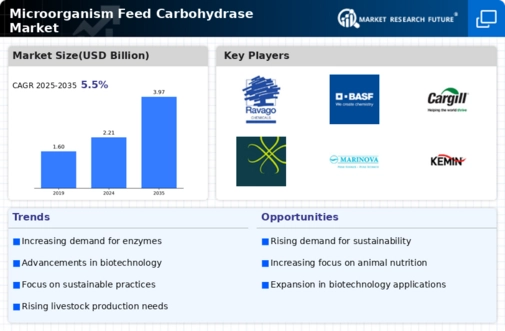Market Growth Projections
The Global Microorganism Feed Carbohydrase Market Industry is poised for substantial growth in the coming years. Projections indicate that the market will expand from 2.21 USD Billion in 2024 to 3.97 USD Billion by 2035. This growth trajectory reflects a compound annual growth rate (CAGR) of 5.46% from 2025 to 2035. Factors contributing to this growth include rising demand for animal protein, advancements in enzyme technology, and increasing awareness of sustainable agricultural practices. As the market evolves, it is likely to attract further investment and innovation, positioning it as a key player in the global agricultural landscape.
Regulatory Support for Enzyme Use
Regulatory frameworks supporting the use of enzymes in animal feed are positively impacting the Global Microorganism Feed Carbohydrase Market Industry. Governments and regulatory bodies are increasingly recognizing the benefits of enzyme supplementation in enhancing animal health and productivity. This support is reflected in the approval of various carbohydrase products for use in livestock diets. Such regulatory backing not only fosters market growth but also encourages research and development in enzyme technologies. As more products gain approval, the market is likely to expand, providing livestock producers with a wider range of options for improving feed efficiency.
Rising Demand for Animal Nutrition
The Global Microorganism Feed Carbohydrase Market Industry is experiencing a notable surge in demand for enhanced animal nutrition. This trend is largely driven by the increasing global population and the corresponding need for protein-rich food sources. As livestock producers seek to improve feed efficiency and animal health, the incorporation of carbohydrases in animal feed becomes essential. These enzymes facilitate the breakdown of complex carbohydrates, leading to better nutrient absorption. In 2024, the market is projected to reach 2.21 USD Billion, reflecting the growing recognition of the benefits of enzyme supplementation in animal diets.
Growing Awareness of Sustainable Practices
The Global Microorganism Feed Carbohydrase Market Industry is benefiting from a heightened awareness of sustainable agricultural practices. As consumers become more environmentally conscious, there is a growing demand for sustainable livestock production methods. Carbohydrases play a crucial role in reducing feed waste and improving feed conversion ratios, thereby minimizing the environmental impact of animal farming. By enhancing the digestibility of feed ingredients, these enzymes contribute to more sustainable livestock production. This trend aligns with global sustainability goals, further driving the adoption of carbohydrases in animal feed.
Technological Advancements in Enzyme Production
Technological innovations in enzyme production are significantly influencing the Global Microorganism Feed Carbohydrase Market Industry. Advances in fermentation technology and genetic engineering have led to the development of more efficient and cost-effective carbohydrases. These innovations not only enhance enzyme activity but also improve stability under various conditions, making them more suitable for diverse feed formulations. As a result, livestock producers are increasingly adopting these advanced enzymes to optimize feed formulations. The market is expected to grow at a CAGR of 5.46% from 2025 to 2035, indicating a robust future driven by ongoing technological progress.
Increasing Focus on Livestock Health and Productivity
The Global Microorganism Feed Carbohydrase Market Industry is driven by an increasing focus on livestock health and productivity. Livestock producers are continually seeking ways to enhance animal performance and reduce health issues associated with poor nutrition. Carbohydrases contribute to improved gut health by facilitating better nutrient absorption and reducing the incidence of digestive disorders. This focus on health and productivity is expected to propel the market, as producers recognize the value of enzyme supplementation in achieving optimal livestock performance. By 2035, the market is projected to reach 3.97 USD Billion, underscoring the growing importance of these enzymes in animal nutrition.

















